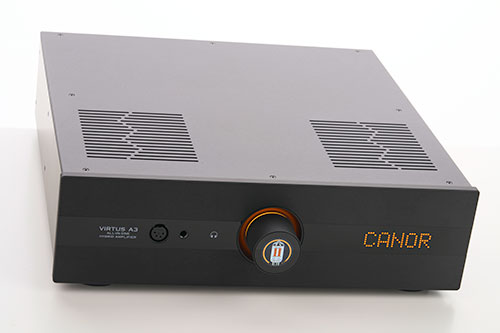
Apart from that, Ansuz Acoustics is not particularly informative, at least on their website. Also, I didn't find any notes on the history and operating methods of the company there, but in the catalogue instead, which, however, you have to download first. Explanations or even white papers about the frequently used so-called "Active Tesla Coils" in their different versions, the "Analog Dither" or the "Anti-Arial & Resonance Coils" aren't to be found on the internet either. Most likely I would have learned more about these specialties on site in Aalborg, but at the planned date of my visit, cross-border travel was no longer possible. Therefore Morten Thyrrested and I agreed to reverse the sequence and to start testing the switch first.
Upon request, Morten Thyrrested gave me access to at least some information about the switches, namely to what basically applies to all four models within the range: According to the Ansuz developers, wired streaming networks are a problem for audiophile environments simply because they are connected to the World Wide Web and thus to all kinds of externally located noisy electronics. In the case of computers, routers, switches and all kinds of other electronics, the background noise is not as important as in the audio sector. Furthermore, the Ethernet is some kind of a floating network, which means that there is no grounding connection to dissipate the noise. With Ansuz Acoustics' PowerSwitches, one of the main advantages is the grounding circuitry, which filters out much of the noise. As mentioned, the PowerSwitches feature a variety of Ansuz technologies to further reduce the noise. These technologies are also compatible with those used in other Ansuz Acoustics products. This way a strong alliance can be built to reduce the noise level within the entire audio system.

The Ansuz Acoustics PowerSwitches also contain - as the term "power" refers to - a PowerBox with ten outputs, which provides power for those Ansuz Ethernet cables featuring active technology. These outputs serve as well to power other Ansuz digital cables. However, for powering analog Ansuz cables, it is recommended to use one of the stand-alone PowerBox models instead. Using a simple voltmeter, I was able to find out that different AC voltages were to be measured at the four sections of the active cable's connecting plug. These are generated by five so-called "Analog Dither" circuits, and are intended to act on the dielectric of the active LAN cables. Though these being also already at hand, they are not going to be part of this test. Nevertheless, the fact that the dielectric is influenced by alternating current instead of direct current as it is the case with the Audioquest cables, intrigued me suchlike that I promptly called Michael Børresen, chief developer at Ansuz Acoustics, who then very willingly provided information about the solutions used. But what the alternating current for the dielectric is all about, I will not reveal until I review the D-TC Supreme Ethernet cables.
-
Keces Ephono+
Nein, ich werde mich ab sofort nicht mehr nur mit günstigen Hifi-Komponenten beschäftigen, auch wenn durch den Test des erschwinglichen Eversolo DAC-Z10 und des Ephono+ der Eindruck entstehen konnte. Denn obwohl Keces der Signalverarbeitung und dem Netzteil je ein eigenes Gehäuse spendiert, ist die Phonostufe für gerade einmal 1.200 Euro zu haben. Ich habe zwar gegenüber Komponenten mit moderaten Preisen genau so wenig Berührungsängste wie gegenüber solchen mit exorbitant hohen – wie sich Anfang des…23.12.2025 -
Galion Audio Navy Röhrenvorverstärker
Wir haben das röhrenbestückte Vorverstärker-Flaggschiff Navy des jungen kanadischen HiFi-Unternehmens Galion Audio unter die Lupe genommen. Der Line-Vorverstärker mit vier Doppeltrioden 12AT7 (ECC81) wartet nicht nur mit hochwertigen Bauteilen auf, sondern er ist das spannende Designprodukt eines high-fidelen Überzeugungstäters. Mir sagte der Markenname Galion Audio bislang wirklich gar nichts. Das junge Unternehmen aus Québec in Kanada wurde 2020 von Thomas Tan, einem passionierten Audiophilen, YouTuber („Thomas & Stereo“) und Content Creator, gegründet. Ziel war, seine…16.12.2025 -
Eversolo DAC-Z10
Meine beiden D/A-Wandler, der DAVE im Arbeits- und der HUGO TT2 im Wohnzimmer, werden serienmäßig von Schaltnetzteilen gespeist. Bei letzterem kommt seit einiger Zeit ein Ferrum Hypsos, bei Chord Electronics Topmodell ein lineares Dreifach-Netzteil zum Einsatz. Ein solches versorgt auch den Eversolo DAC-Z10 – zum Preis von 2.000 Euro. Und nein, es sind keine drei ausgelagerten Stromversorgungen, für die der genannte Preis gilt. Dafür bekommt man das vollständige Topmodell unter Eversolos DACs. Es ist schon…09.12.2025 -
Raidho X2.6 Standlautsprecher
Mit Lautsprechern von Raidho haben wir uns bei Hifistatement schon öfter beschäftigt. Im Fokus standen dabei die Kompaktlautsprecher TD1.2 aus der TD-Serie sowie X1t und X1.6. aus der X-Serie. Diesmal haben wir den Standlautsprecher X2.6 zu Gast, das aktuell größte Modell der X-Serie. Raidho verspricht, mit der X-Serie besonders viel Leistung – sprich Klangqualität – für den aufgerufenen Preis zu bieten. Wobei, „billige“ Lautsprecher – ganz gleich nach welchem Maßstab - hat Raidho noch nie…02.12.2025 -
Canor Virtus A3
Zur diesjährigen HighEnd stellte Canor den Virtus A3 Hybrid-Vollverstärker vor. Der lockt mit einem integrierten Digital-Analog-Wandler und einer diskret aufgebauten Phono-Vorstufe für MM- und MC-Tonabnehmer. Sowohl seine Technik als auch die Ausstattung bieten Ungewöhnliches. Vor allem aber soll er klanglich beeindrucken. Das slowakische Entwickler-Team konnte mich bereits vor einem Jahr überzeugen: Der Vollverstärker Virtus I2 aus der Premium Line musizierte in meinem Hörraum wie keiner zuvor in dieser Preisklasse. Der war ein gestandener Röhren-Vollverstärker. Auch…28.11.2025 -
Dan D’Agostino Progression S350
Dan D’Agostino ist eine Legende im Verstärkerbau. Er folgte wohl nie einer Mode, sondern vertraut bei allen Entwicklungen seinem Gehör und seiner Leidenschaft für den guten Klang. Mehr als 50 Jahre baut er nun schon Verstärker, immer mit dem Ziel, das „Wesen der Musik hörbar zu machen“. Erfüllt auch der S350 diese hoch gesteckten Ambitionen? Die Progression S350 ist die kleinste Stereoendstufe im Gesamtprogramm. Optisch trägt sie alle charakteristischen Merkmale einer echten D’Agostino. Angefangen mit…25.11.2025
© 2025 | HIFISTATEMENT | netmagazine | Alle Rechte vorbehalten | Impressum | Datenschutz

























 |
|




















































































